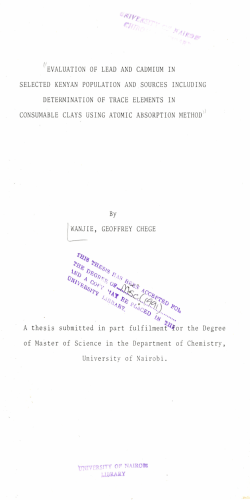
PHYSICO-CHEMICAL ANALYSIS OF GROUNDWATER IN A
PHYSICO-CHEMICAL ANALYSIS OF GROUNDWATER IN A NIGERIAN COMMUNITY Session No. 214 T77. Undergraduate Research Projects As a Way to Solve Water- Related Problems/Issues (Posters) Ndambuki, Julius M1; Bamgbelu Oluwatobiloba2; Omole, David O.1,2 1 Department of CIVIL Engineering, TSHWANE UNIVERSITY OF TECHNOLOGY, Pretoria, 0001, South Africa 2 Department of CIVIL Engineering, COVENANT UNIVERSITY, Ota, 234, Nigeria ABSTRACT: Groundwater is the most accessed freshwater source in Nigeria. However, the groundwater resource sector of Nigeria is confronted with pollution problems arising from both natural causes and human activities. The current study examines the case of a faith-based campus whose water needs are 100 % serviced via groundwater. The campus accommodates about 15,000 full time residents and about 200, 000 weekly visitors. The campus is provided with water from 30 boreholes which is pumped directly into elevated tanks. Four water samples which were obtained from four boreholes within the campus were analysed for physico-chemical contaminants using standard methods. This was done to confirm the potability of the water which is being consumed by residents. Results of the analysis of the groundwater in the study area showed that all the water samples met the minimum requirements of the National Standard for Drinking Water Quality (NSDWQ) for sulphate, nitrate, chloride and Total Dissolved Solids (TDS). However, 75 % of the water samples were slightly acidic as they fell below the NSDWQ range limit of 6.5 – 9.5. Furthermore, all the water samples exceeded the NSDWQ limit of 400 mg/L for hardness. Cadmium was also found to exceed the NSDWQ limit of 0.003 mg/L in all water samples while 50 % of the water samples slightly exceeded the 0.5 mg/L limit for Iron. The presence of cadmium in most of the water sample suggests that there is high risk in consuming water from these boreholes. Cadmium is a very toxic metal which bio-accumulates in the body. This leads to neurological problems as well as organ failure which ultimately leads to death. Similar experiments conducted by other students in the past five years suggest that the problem of cadmium is persistent. Also, results of soil tests conducted by another group of students suggest that the ambient soil may be the source of this pollutant since all four tested soil samples contained cadmium with values ranging between 28, 800 % to 1.36 million % of the limit for cadmium in water. Due to the life threatening effect of cadmium on humans, it was concluded that water from the study area should not be consumed without treatment. These experiments which were conducted by students of the university demonstrate that undergraduates can contribute to solving the myriads of water related problems in the society. BACKGROUND: Nearly 40% of Nigerian population withdraws groundwater for domestic use. The water is often consumed without any form of treatment because it is perceived to be pure. This is not often true. NIGERIAN HOUSEHOLD DISTRIBUTION BY SOURCE OF DOMESTIC WATER SUPPLY (Longe et al., 2010) EDUCATION: Young scientists (under graduates) are being trained to investigate and address water quality problems in a campus which depends totally on groundwater and has 15,000 residents. RESULTS: The student researchers were able to confirm that groundwater being used in the campus was slightly contaminated by Cadmium, a very toxic metal. They recommended treatment before use and are currently working on means of removing the contaminants using indigenous technology. CONCLUSION: The younger generation has a lot of ideas that can be tapped in solving society’s problems. They only need to be shown how it is done. ON-GOING RESEARCH TOPICS: 1. Removal of heavy metals using activated carbon 2. Development of a water treatment plant Acknowledgement: National research foundation of South Africa for award of travel grant. Covenant University and Tshwane University of Technology for use of space and resources Presented At: 2014 GSA Annual Meeting, Vancouver, British Columbia.
© Copyright 2026





















